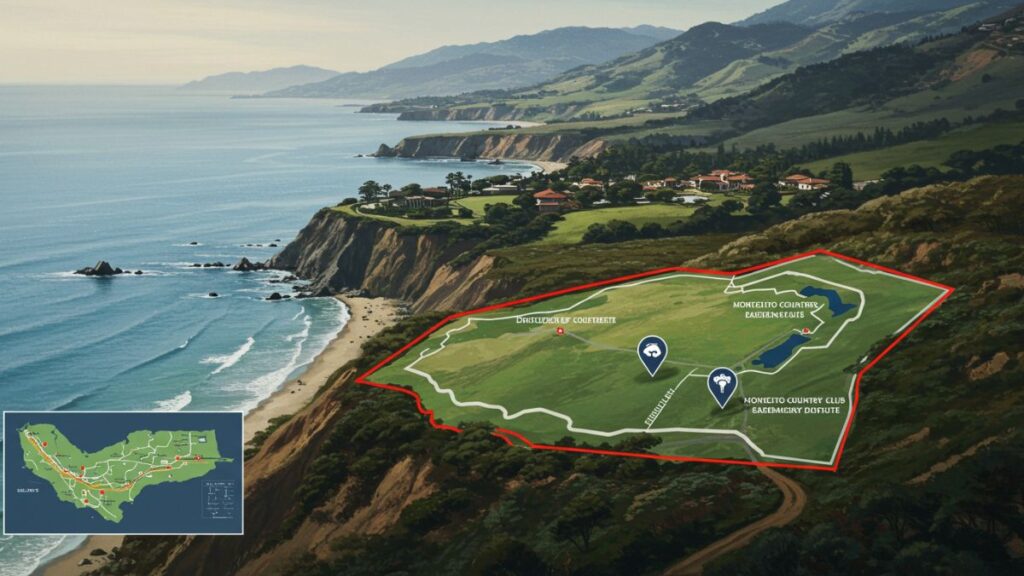The Montecito Country Club easement dispute has drawn intense scrutiny from homeowners, club members, and legal experts alike. Centered on whether the club retains a long-held right to cross privately owned land, this disagreement hinges on historical agreements, evolving property values, and differing interpretations of California easement law. In this article, we delve into the background, the main stakeholders, legal arguments, and the possible paths forward for resolving the Montecito Country Club easement disputes.
Background of the Montecito Country Club Easement Dispute
Historical Origins of the Easement
The roots of the Montecito Country Club easement disputes trace back to the early 20th century, when the club first acquired contiguous parcels for its golf course and clubhouse. At that time, landowners granted the club an express easement to traverse certain parcels for maintenance and guest access. Over decades, as properties changed hands, the exact terms of that easement became obscured, setting the stage for disagreement.
Changing Landscape of Montecito
In recent years, Montecito has transformed into one of California’s most exclusive enclaves. Property values have soared, and new homeowners are more protective of privacy and control. Against this backdrop, those owning land adjacent to the country club have questioned whether the original easement remains valid, or whether it should be extinguished or renegotiated.
Key Parties in the Montecito Country Club Easement Dispute
Country Club Stakeholders
The Montecito Country Club, represented by its board of directors and counsel, argues that the easement is both legally enforceable and essential to its operations. Club leadership maintains that depriving members of the established access route would significantly diminish the member experience and the club’s market value.
Adjacent Property Owners
On the opposing side stand several private landowners who contend that the easement either expired by its own terms or was never properly recorded against their titles. These owners emphasize their right to full enjoyment of their property, free from unneeded pedestrian or vehicular traffic.
Legal Arguments and Precedents in the Montecito Country Club Easement Dispute
Enforceability of Express Easements
An express easement arises from a written grant or reservation. The country club points to archival documents—deeds and plats—from the 1920s. Yet opponents argue that the language in those deeds lacked sufficient clarity to bind subsequent grantees.
Implied and Prescriptive Easements
Beyond the express claim, Montecito Country Club asserts a secondary basis: implied easement by necessity, since no practical alternative route exists to reach certain facilities. Additionally, continuous use over nearly a century could qualify as a prescriptive easement, provided there was use that was open, notorious, and uninterrupted for at least five years.
California Case Law
The dispute will likely invoke leading California precedents, such as Ogilvie v. City of Los Angeles on implied easements and Ingersoll v. Meyer on prescriptive rights. Courts often balance strict property rights against equitable considerations—especially when longstanding community practices are at stake.
Community Impact of the Montecito Country Club Easement Dispute
Residents’ Concerns
For many Montecito residents, the country club is more than a golf course; it’s a social hub. A loss of access could reduce property values in the vicinity and alter traffic patterns. Meanwhile, homeowners directly adjacent to the disputed corridor worry about trespassing, noise, and liability exposure.
Economic and Social Stakes
Local businesses—caterers, event planners, nearby shops—benefit from club events. Should the Montecito Country Club easement disputes resolve against the club, cancellations and relocations of weddings, charity fundraisers, and tournaments could ripple through the economy.
Potential Resolutions for the Montecito Country Club Easement Dispute
Mediation and Alternative Dispute Resolution
Parties may choose private mediation, seeking a compromise that adjusts the easement route, sets hours of use, or provides monetary compensation. This path often preserves relationships and avoids protracted litigation costs.
Formal Settlement Agreements
A negotiated settlement could redefine the scope of the easement—narrowing it to pedestrian traffic only, limiting vehicle size, or rerouting around sensitive areas. In exchange, the country club might pay neighboring owners a one-time fee or ongoing maintenance contributions.
Court Adjudication
If no agreement is reached, the disagreement will proceed to trial. Judges will interpret deed language, evaluate historical use, and apply California easement statutes. A ruling could confirm the easement, partially limit it, or extinguish it altogether, setting a binding precedent.
Looking Ahead: The Future of the Montecito Country Club Easement Disputes
Long-Term Implications
Regardless of the outcome, this dispute highlights the importance of clear documentation and regular re-recording of easement terms. Landowners and institutions alike will take note, ensuring that future developments rest on unambiguous legal foundations.
Maintaining Community Harmony
Even as legal processes unfold, community leaders and club officials should engage transparently with residents. Open forums, informational brochures, and shared site walks can demystify the issues and foster goodwill.
Conclusion
The Montecito Country Club easement dispute exemplifies the challenges that arise when historical property arrangements meet modern expectations. Through a combination of legal argumentation, negotiation, and community engagement, the parties involved have an opportunity to forge a solution that respects both the sanctity of private land and the cherished traditions of Montecito Country Club. As the dispute advances, all eyes will be on how California law navigates this nuanced intersection of easement rights and contemporary land use.


